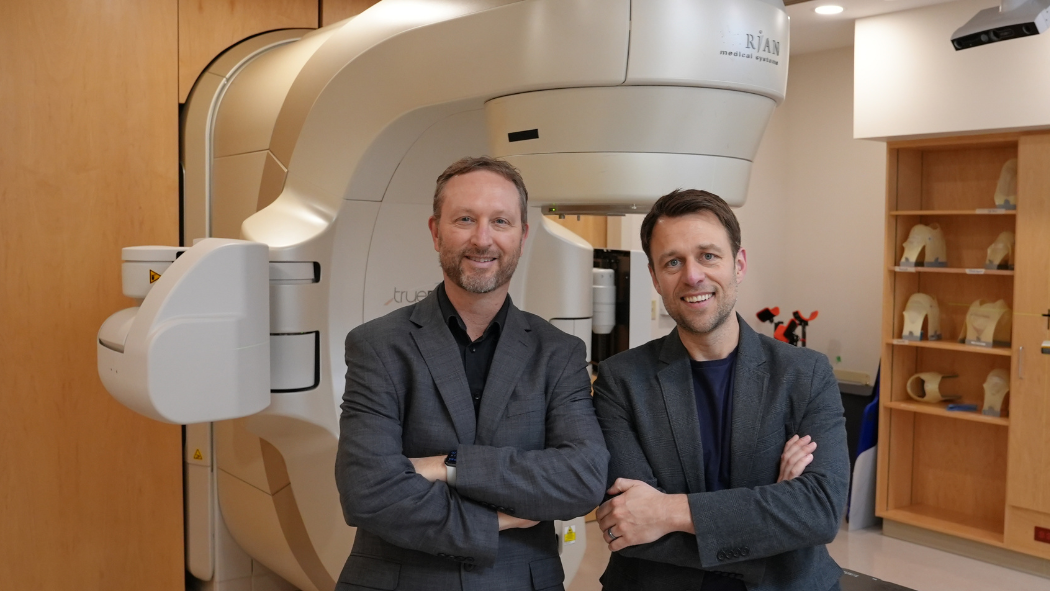
Image: From left to right - Drs. Stewart Gaede and Daniel Breadner
November 29, 2023
The Baker Centre for Pancreatic Cancer at London Health Sciences Centre (LHSC) opened in 2019 as part of the vision of Rick and Shelley Baker. They generously donated $1.5 million to support pancreatic cancer care and research in the London region after Rick was diagnosed with pancreatic cancer.
The Baker Centre provides pancreatic cancer patients with access to new treatment options and to a more specialized level of care through participation in research and clinical trials.
There are a variety of research studies available for eligible patients to participate in at the Baker Centre. One of them is led by Dr. Stewart Gaede, Chief Medical Physicist at London Regional Cancer Program (LRCP) and Associate Scientist at Lawson Health Research Institute and Dr. Daniel Breadner, Medical Oncologist, LRCP at LHSC and Associate Scientist at Lawson.
SABR use on pancreatic cancer
Drs. Gaede and Breadner are studying the effect of stereotactic ablative radiotherapy (SABR) on resectable and borderline resectable pancreatic cancer. Traditionally, because pancreatic cancer is more challenging to diagnose and treat, the role of radiation therapy in pancreatic cancer has been limited because of a risk of toxicity to surrounding organs and because the tumor is hard to visualize in imaging scans.
With pancreatic cancer, it often spreads rapidly to the lymphatic system and other organs and has a dense layer within the tumour that may inhibit blood flow. These factors result in a limited number of cancer therapies and can make the therapies used less effective.
SABR, however, is a targeted therapy that delivers a high dose of radiation in fewer treatments than other radiotherapy treatments and has the potential to provide more effective systemic therapy to pancreatic cancer patients.
“The goals of the study are to increase the chance of cure for patients with early stage pancreatic cancer, to learn about the benefits of SABR in pancreatic cancer and use that information to make other established treatments more effective,” says Dr. Breadner.
This study leverages the technological advances in imaging and radiation therapy technology available at LHSC to explore potentially new treatment options.
“For those patients who present with this disease in its early stages, there is an opportunity to potentially improve the effectiveness of treatment prior to surgery using the SABR method,” Dr. Gaede explains.
This treatment method that’s being studied is considered “neoadjuvant” which is treatment given before the primary cancer treatment (e.g., surgery) to help enhance the outcome of the primary treatment.
Imaging the tumour and preparing for treatment process
This trial aims to assess the safety and efficacy of delivering high-dose SABR in three treatments to resectable and borderline resectable pancreatic cancer populations, and to assess the treatment response. The assessment includes examining changes in blood flow to the area and to the immune system.
“Since the pancreas is difficult to see on images like x-ray and computed tomography (CT), endoscopists use ultrasound as guidance to implant gold fiducial markers in or around the pancreas,” explains Dr. Breadner. “The markers are designed to be visible and safe for magnetic resonance imaging (MRI), positron emission tomography (PET) and CT imaging while anchoring in place.”
The patients receive a PET/MRI scan to not only better see the pancreas, but to determine any areas within the tumour where there is low oxygen that could cause treatment resistance.
They also receive a CT scan to measure blood flow in the tumour and a separate CT scan to plan the SABR treatment.
“Using the PET/MRI scan helps to define the area of the tumour on the CT scan where the patient will be treated and assesses respiratory motion of the tumour and whether a patient is able to hold their breath consistently,” shares Dr. Gaede.
Treatment process in trial
In the trial, patients receive three SABR treatments, one given every other day, completing the treatment within one week.
“When delivering treatment, the patient’s breathing and breath-hold states are monitored by a system that measures the surface motion of the patient in real-time,” Dr. Gaede explains. “This ensures that the patient is always in the right spot when the treatment is delivered.”
The health care providers also confirm, through the use of x-ray images made during treatment, that the gold markers are in the right place. These images are captured every three to five seconds to ensure accuracy.
The patient will get a CT scan three to four weeks post-treatment and prior to surgery to see if there is continued blood flow change.
Ongoing trial
“We are considering several questions as we continue our research,” says Dr. Gaede. “We’re asking if SABR can address the challenges in treating certain pancreatic cancers, if SABR can promote an immune response, and if we can increase blood flow and overcome lack of oxygen in the tumour with SABR, among other inquiries. We look forward to sharing results when the trials conclude.”
This clinical trial is still ongoing and is funded through London Health Sciences Foundation (LHSF) from Verspeeten Cartage, the Ontario Institute for Cancer Research (OICR) and the Academic Medical Organization of Southwestern Ontario (AMOSO) grants.
Drs. Breadner and Gaede both agree that this trial would not be possible without the Baker Centre. “This space has provided the opportunity to bring together Radiation Oncology, Medical Oncology, Surgical Oncology, Gastroenterology, Radiology, Pathology and Medical Imaging,” notes Dr. Gaede.
“The collaboration between experts in these areas has been important for our research and to provide the best care for patients,” says Dr. Breadner.